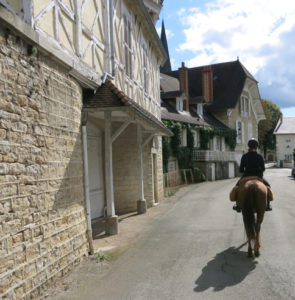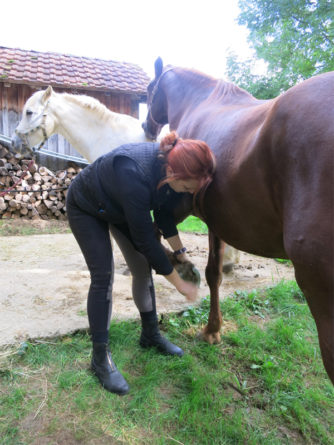JURA MOUNTAINS ON HORSEBACK
The rhythmic, clopping of horses’ hooves, the faint rustle of a breeze through leaves and the melodic chimes of cowbells wafting up from the meadows – are just some of the sounds that will accompany you on a ride through the Jura mountains of France.
Located north of the Western Alps, and mainly following the course of the France–Switzerland border, the Jura separates the Rhine and Rhône basins, forming part of the watershed of each. In France, the Jura covers most of the Franche-Comté region, stretching south into the Rhône-Alpes region.
Much of this area is vineyard country, with forested hillsides and dramatic rocky outcrops bursting through the greenery to provide the perfect perch for ancient fortresses casting their protective eye over the land below. The Grande Traversee du Jura is a route traditionally enjoyed on foot, then mountain bike, and now, with more bridleways open, on horseback.
The entire route would take at least three weeks continuous travel – and this is not recommended for human or horse. But dipping in for a few days to cover a section that appeals to you is the perfect way to see the area and experience what this region of France has to offer.

The terrain is varied and you can pick your sections to suit your preference and your ability. For example, from Crouzet-Migette to Arbois requires good horsemanship skills, experience of trail riding, the ability to mount from the ground, competent navigation skills, and a willingness to spend around eight hours in the saddle (plus additional time for lunch and comfort breaks). There are some very steep, tricky sections, that do require a more advanced ability and confidence.
Whereas the route from Arbois to St Lothain, or from St Lothain to Lavigny is much easier going and would suit a less experienced rider. They are also shorter routes and can be taken at a more leisurely pace – allowing you to soak up the scenery.
All routes can be ridden self-guided (only recommended if you are a confident rider and navigator, and willing to take on a real adventure) and guided (suitable for most abilities and a more relaxing way to experience the route).
 The riding, whichever section you choose, will take you through tiny hamlets with narrow streets and creamy coloured stone houses, their window boxes overflowing with bright red pelargoniums, along forest trails with sunlight slanting through the branches throwing splashes of golden light across your path, past sheer rock walls hiding caves and fairy grottos behind the ferns and curtains of moss, through soft green meadows with the emblematic Montbeliarde cows whose milk makes the region’s famous Comté Cheese, and, of course, past rows, and rows of vines marching in soldiery lines across the valley belying the effects of the alcohol they produce.
The riding, whichever section you choose, will take you through tiny hamlets with narrow streets and creamy coloured stone houses, their window boxes overflowing with bright red pelargoniums, along forest trails with sunlight slanting through the branches throwing splashes of golden light across your path, past sheer rock walls hiding caves and fairy grottos behind the ferns and curtains of moss, through soft green meadows with the emblematic Montbeliarde cows whose milk makes the region’s famous Comté Cheese, and, of course, past rows, and rows of vines marching in soldiery lines across the valley belying the effects of the alcohol they produce.
 The Grande Traversee du Jura office can arrange your horse hire (around 50 euros per day per horse) and for the horses to be transferred back to their home farm after the trip. You just need to bring your own riding gear and arrange appropriate insurance. We picked up our horses, Lily, a tall 16 hand chestnut, and Paloa a smaller grey, from Ferme Equestre du Pont du Diable, in Crouzet-Migette where we took a short hack to get to know our steeds before we set off the following morning. This section of the route is quite tough so if you want something a little easier on your first day, you can arrange for you, and your horses, to be transferred.
The Grande Traversee du Jura office can arrange your horse hire (around 50 euros per day per horse) and for the horses to be transferred back to their home farm after the trip. You just need to bring your own riding gear and arrange appropriate insurance. We picked up our horses, Lily, a tall 16 hand chestnut, and Paloa a smaller grey, from Ferme Equestre du Pont du Diable, in Crouzet-Migette where we took a short hack to get to know our steeds before we set off the following morning. This section of the route is quite tough so if you want something a little easier on your first day, you can arrange for you, and your horses, to be transferred.
I’d recommend dinner at Auberge du Pont du Diable. It’s owned by a French-English (Yorkshire, to be precise) couple, so if you haven’t quite got your French language skills up to par, don’t worry – the menu comes in English and so does the conversation. The food is freshly cooked and delicious and there are plenty of options for vegetarians too (something you won’t find in many places in France).
The accommodation along the route ranged from luxurious (Domaine De Saint-Loth – like staying in a mini castle that serves the best bramble jelly I have ever tasted) to rustic and personal (Ferme Des Nouvelles – where Marie Jo and Maurice welcomed us into their home and we ate dinner at their giant kitchen table). At each location there is a place for your horses – whether that’s a stable or a field for grazing. So, once you’ve untacked, checked hoofs and coats, and ensured they have food and water, you can sit back knowing your horses are also enjoying their evening.

Experiencing the region on horseback is, for me, the perfect way to do it. I see so much from the back of a horse and feel more connected to nature as, together, we make our way along the mountain trails each day. Carry your picnic with you and stop off when you feel peckish or the perfect sunny spot appears.
With leisurely walks through the woods, trotting along the field edges, and cantering across great open meadows – what more could you want from a few days on The Grande Traversee du Jura?
FACT BOX
 Bourgogne–Franche-Comté Tourisme – www.montagnes-du-jura.fr
Bourgogne–Franche-Comté Tourisme – www.montagnes-du-jura.fr
Grandes Traversées du Jura – www.gtj.asso.fr
Auberge Du Pont Du Diable – https://aubergedupontdudiable.com/
Ferme Equestre Du Pont Du Diable – www.ferme-equestre-pontdudiable.com
Ferme Des Nouvelles – www.ferme-des-nouvelles.fr
Maison Du Haut – www.maisonduhaut.com
Domaine De Saint-Loth – http://saint-loth.fr/
Logis Neuf 25 – www.gite-etape-lavigny.com
Le Relais De La Perle – www.chambres-hotes-jura.biz
ABOUT THE AUTHOR
Chantal Cooke is an award-winning journalist and broadcaster with a passion for the planet. In 2002 she co-founded the award-winning radio station PASSION for the PLANET and in 2009 Chantal was awarded London Leader in Sustainability status. Chantal also runs a successful communications agency – Panpathic Communications.

